Descheemaecker taught his people to race pigeons.
20 minute read - by Joseph Descheemaecker
In November 1936, the brothers Noël and Robert Descheemaecker founded the Natural company. The brothers’ fascination for pigeon racing was so great that Natural became their life work. Noël Descheemaecker remained passionately involved with pigeon racing up to up to the age of 92.
After his sons Joseph and Noël Jr. took over the company, he continued to follow the business and share the enjoyment of its success. The young generation had but one aim, and saved neither effort nor expense in its pursuit: quality products for pigeon racing. Natural products are well known in no fewer than 55 countries all over the world. Joseph‘s son, Stephan Descheemaecker, was the third generation to take the helm. The well-beaten track was boldly pursued further. An ultra-modern, brand new production unit for grain mixes ensures and maintains excellent quality. In the Descheemaecker Pigeon Center, Stephan Descheemaecker focuses on Elite Pigeons: pigeons with an exceptional pedigree. The long collaboration with China has also achieved a totally new dimension.
Descheemaecker‘s story is unquestionably part of the pigeon racing heritage, and is definitely worth telling.

The first pigeon loft of the brothers Noël and Robert Descheemaecker in Wilrijk (Antwerp). It was built in 1927 on the roof of their father’s printing press.
November 1930.
Noëls' and Roberts' father had a small printing business in Wilrijk. Sharing the same interest and passion, the brothers decided to publish a journal, "Het Duivensport [Pigeon Racing]", in November 1930. Twenty-five sample copies were printed and handed out amongst friends and acquaintances along with a request for feedback. It was a simple journal with no advertisements, only articles written from experience.
Enthusiastic pigeon-fancier friends, who raced their pigeons at a high level, guaranteed the content. The journal was an enormous success right from the start with 50,000 copies being printed.
It was popularly known as 'the green booklet', due to its green cover. The journal was handed around, laid in every clubhouse, and readership was estimated at 240,000.
The French version, “Le Sport Colombophile”, was just as popular in Wallonia. Noël Descheemaecker‘s wife was Wallonian, so she knew how to successfully provide the Walloon contacts.
Suddenly it was all hands on deck at the printers, working day and night to print and distribute the journal.
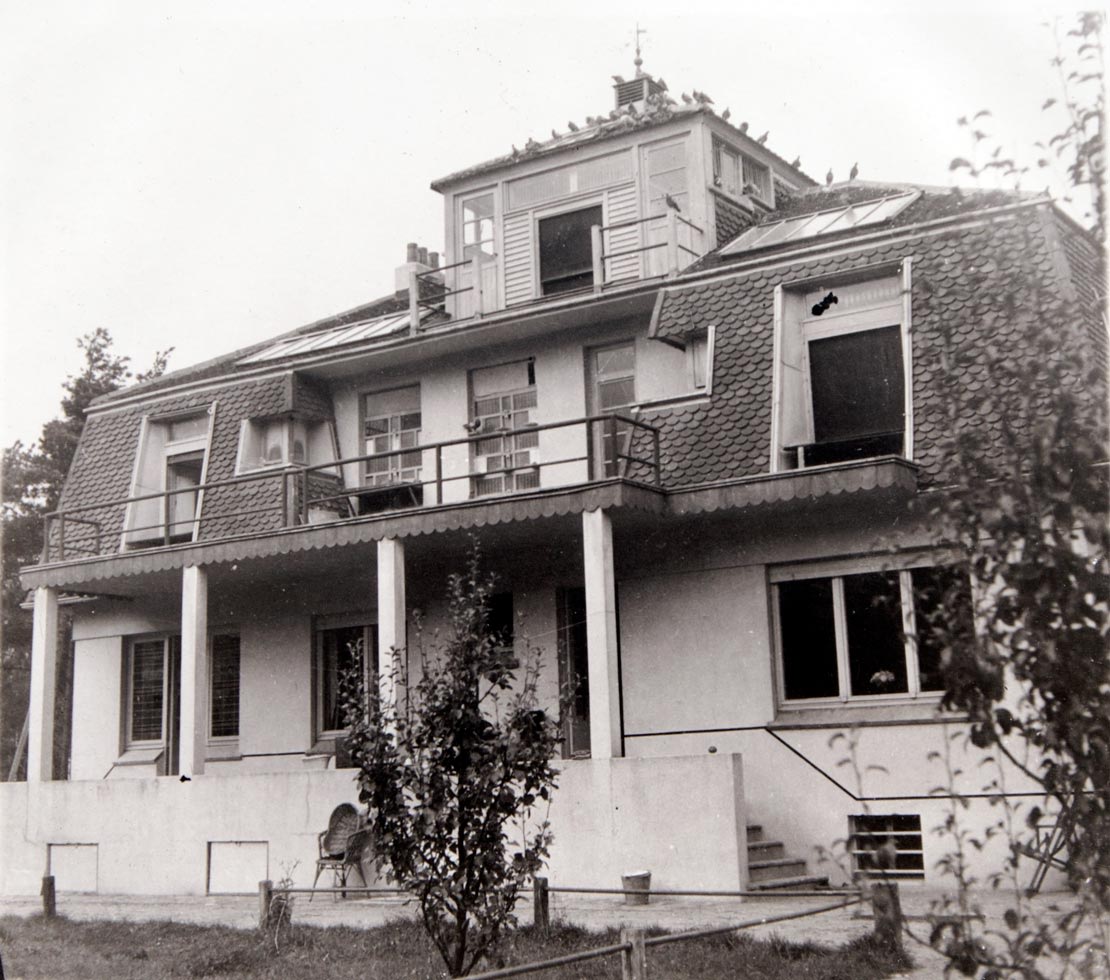
In 1938, a large pigeon loft was built in the garden of Noël Descheemaecker in Schoten based on the loft model of the Walloon champion Georges Fabry (Liège).
The pigeon, the racehorse of the poor.
Luik had been the cradle of pigeon racing since the 19th century. Pigeon racing was seen by the moneyed public as a separate sport, a leisure activity for poor people. In nearly all surrounding countries, pigeon racing arose in the coal-mining regions: North Pas-De-Calais in France, the Ruhr Area in Germany, Blackpool in England, and Katowice in Poland. The pigeon became the racehorse of the poor man. Workers had no money to travel, so the pigeons were practically their only form of recreation.
They worked six days a week and so there was no time to race the pigeons over long distances. Pigeon racing in that era was limited to 'pure speed', flights of 250 kilometres. People stopped work at 4.00 pm on Saturdays. The pigeons were released, and their owners went to the clubhouse to relax. The pigeons were basketted on Saturdays. Most flights were limited to 100 kilometres; hence with a tailwind the pigeons were back home within an hour and a quarter after their release on Sunday. On Sunday mornings in the clubhouse, the clock was brought out on which the pigeons were registered as they arrived home from the flight. The pigeon flying the shortest time between release point and home loft was the winner.
A single village sometimes had several pigeon clubs, depending on the political leanings of the members. These clubs were also specifically positioned: one in the north, south, east and west, for every (kilo)metre counted depending as it did on the home loft location in relation to the release location.
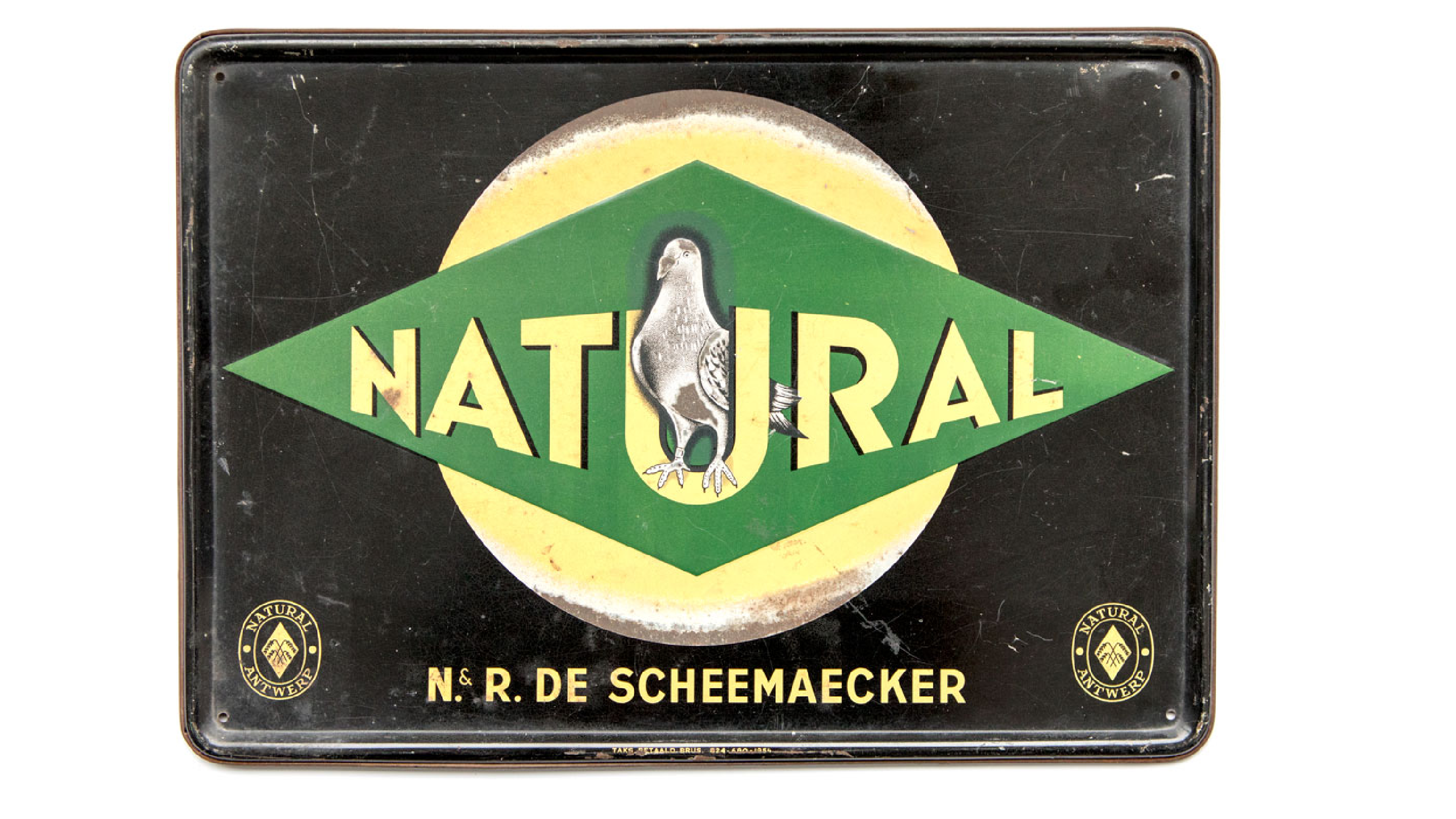
First logo in 1930.
From lawyer to retailer.
Unsurprisingly, Noël and Robert also raced pigeons in the De Zwaluw club in Wilrijk. They learned the tricks of the trade from Gust De Feyter, friend and fellow pigeon fancier. At one point they came in contact with Evrard Havenith, a well-known Antwerp pigeon fancier, who sold them a sack of field beans of the best quality. This awoke their interest in homing pigeon feed, which later turned out to be an important success parameter. The entire content of a journal was hence devoted to the importance of quality grain mixes specifically for pigeons. Meanwhile, the journal had brought in quite a bit of cash, and the idea grew of setting up a business to produce pigeon feed. Noël Descheemaecker had already begun a lawyer's practice, but hung up his toga to fully devote his time to his passion.
The brothers bought a plot of land and built a production facility on it. They purchased a second-hand van and, in November 1936, the company of Natural Granen – Gebr. Descheemaecker NV was born. Then only four mixes were available: breeding, sport, moulting, and winter. Initially, these mixes were offered in sacks of 25 kg, but in order to meet the demands of pigeon fanciers, they switched to sacks of 5 and 10 kg.
The brothers themselves brought these to the nearby miller, local retailer and clubhouses, who in turn sold them on to the pigeon fanciers.
The business ran extraordinarily well right from the start. The success was partly based on the journal “Het Duivensport”. The brothers achieved good results with pigeon racing, and used their experience to write articles from which other pigeon fanciers could learn. And of course Noël had the advantage of his university education. His father insisted that he first obtain his law degree, and only then fully devote himself to pigeon racing. In the final year of his study, Noël was practically always absent from lectures because he had too much work to do with his pigeons. The times he did appear at lectures, the professor would say, "Well, well; the famous pigeon fancier honours us once more with his presence!".
The saying, "Conscience taught his people to read; Descheemaecker taught his people to race pigeons", dates from his period.

‘Het Duivensport’ published in 1930 by the Descheemaecker brothers had more than 40,000 readers in 1939. ‘Le Sport Colombophile’ is the name of the French-language edition of ‘Het Duivensport’. Both the journals have been the most widely read pigeon magazines in Belgium, for more than 90 years.
Pigeon racing and gambling
Since pigeon racing was the horse racing of the poor man, it was only natural that people bet on the pigeons. From the outset, the brothers earned good money with their pigeons. Noël Descheemaecker could even finance his studies this way.
In those days, pigeons could only be raced when the town hall was open. An odd rule, but thus was a blind eye turned to the fact that people bet on the pigeons.
Much money was staked on the long flights. The club received one percent of the bet, and hence pigeon racing could continue to flourish.
The city of Liège saw the most gambling. There you could register your pigeon in different clubs in order to raise the chance of profiting. The peak of pigeon racing was reached in the period 1830-1840. Carrying their pigeons on their backs, pigeon fanciers from Flanders travelled to Liège to participate in races. The release of the pigeons was an event that attracted large crowds at the time.
'Kaers'.
The brothers not only purchased a sack of quality beans from the renowned Evrard Havenith (which lead directly to the production of pigeon mixes), they also bought a top pigeon named 'Kaers'. She was named after the cyclist Karel Kaers, who reaped much success in the 1930s, and in 1934 became world champion in track cycling.
In the journal "Het Duivensport", Kaers played the leading role in the articles written by Noël Descheemaecker. These articles revealed the secret behind the strong performances of this top pigeon: "escape from the crowd right from the beginning of the race".
During her training, the brothers did not allow Kaers to fly with pigeons from their region. Instead, they taught her to fly alone. There is an enormous advantage when you teach a pigeon to leave the group and choose the right direction. The essence is to teach pigeons to navigate independently.
One day, the Descheemaecker brothers were challenged as young lads to take part with Kaers in the very competitive club, De Zwaluw. Kaers promptly won first prize.
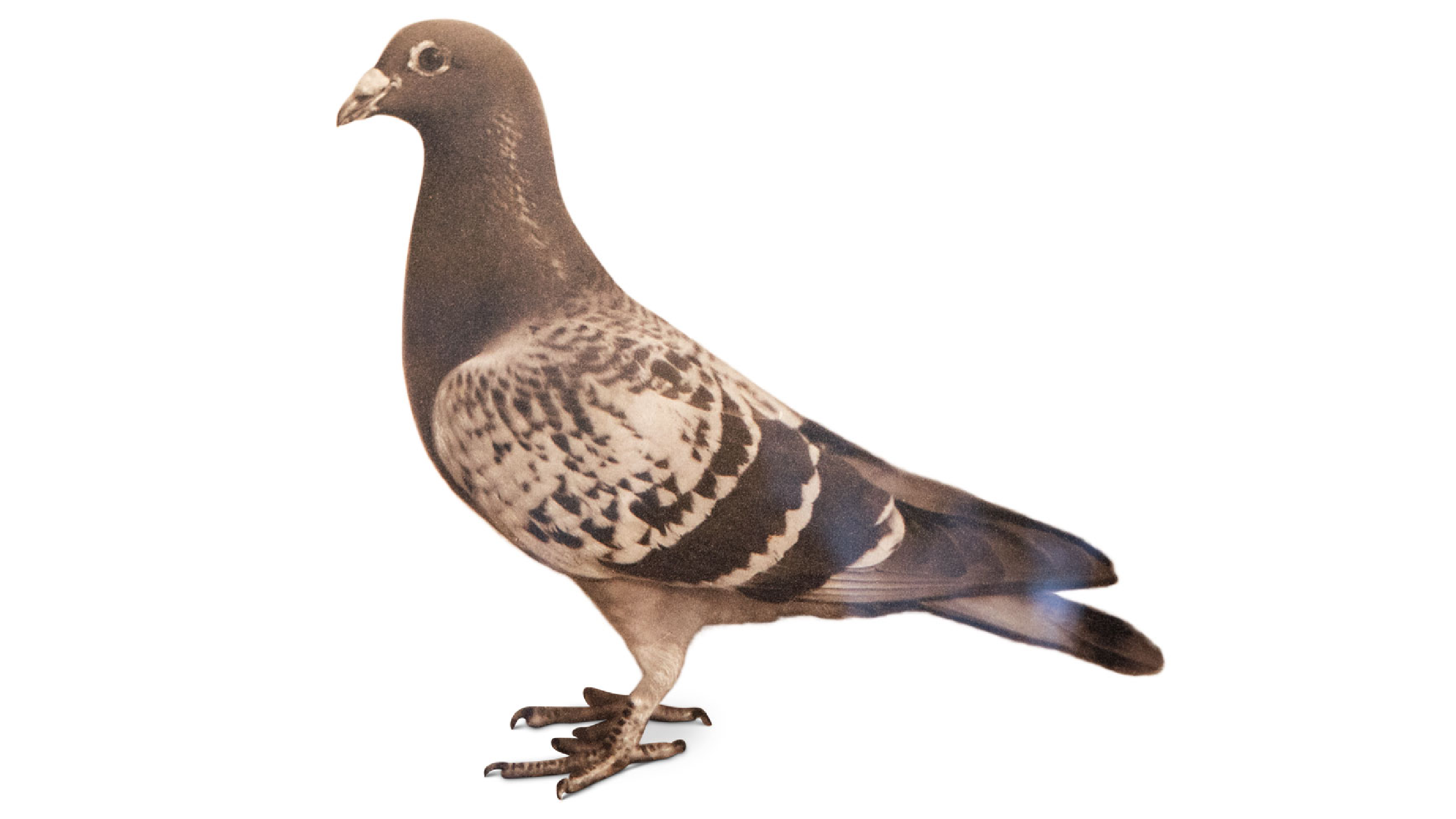
‘De Kaers’: in 1932, the Descheemaecker brothers purchased a young male pigeon from their friend Havenith 6136542-32. He was named ‘De Kaers’. For seven years, ‘De Kaers’ was one of the best middle-distance pigeons in the province of Antwerp. He ended his sporting career in 1939 after winning the first prize of Orléans (400 km) in the Antwerp Union, also known as the high school of the Belgian pigeon sport.
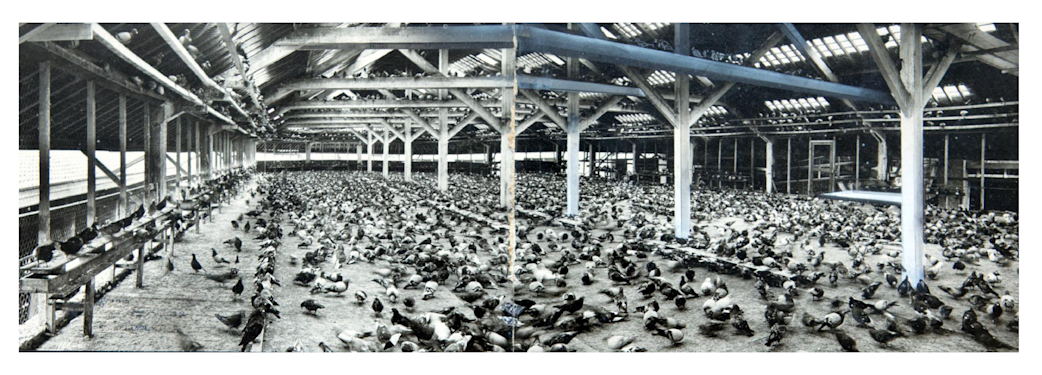
Belgian homing pigeons held in captivity in a large aviary during the war.
World War II
For Noël and Robert, pigeon racing was not restricted to Belgium. Their name and fame reached beyond the border. At the end of the 1930s, they were invited to many international pigeon shows to share their expertise and judge pigeons.
At a pigeon show in Cologne in Germany, the brothers received the visiting card of a German general. The swastika on the card would later play a decisive role for Belgian pigeons.

In the past, the homing pigeon has played an important role in the army as a messenger.
1940: the outbreak of World War II.
In German-occupied countries, all pigeons had to be slaughtered, because they might be deployed for espionage purposes. This was already a known practice during the French Revolution, and also in World War I pigeons were regarded as soldiers.
Noël and Robert wanted to do everything possible to prevent their pigeons and those of the Belgian fanciers being slaughtered. They asked the German general they met in Cologne before the War to help them. This general was a pigeon fancier in heart and soul, and he provided a solution. He gave permission for the Belgian pigeons to be moved to special dovecotes in Brussels, where they remained in exile until after the War. The pigeons were not raced during the War, and the Belgian Pigeon Association took care of them. The sale of grain mixes ceased and, unluckily, a V2 bomb destroyed a large part of the Natural factory.
However, the brothers' efficient action resulted in the Belgian pigeon fanciers being able to immediately resume racing their pigeons at the close of the War. The Belgian pigeons had survived the War.
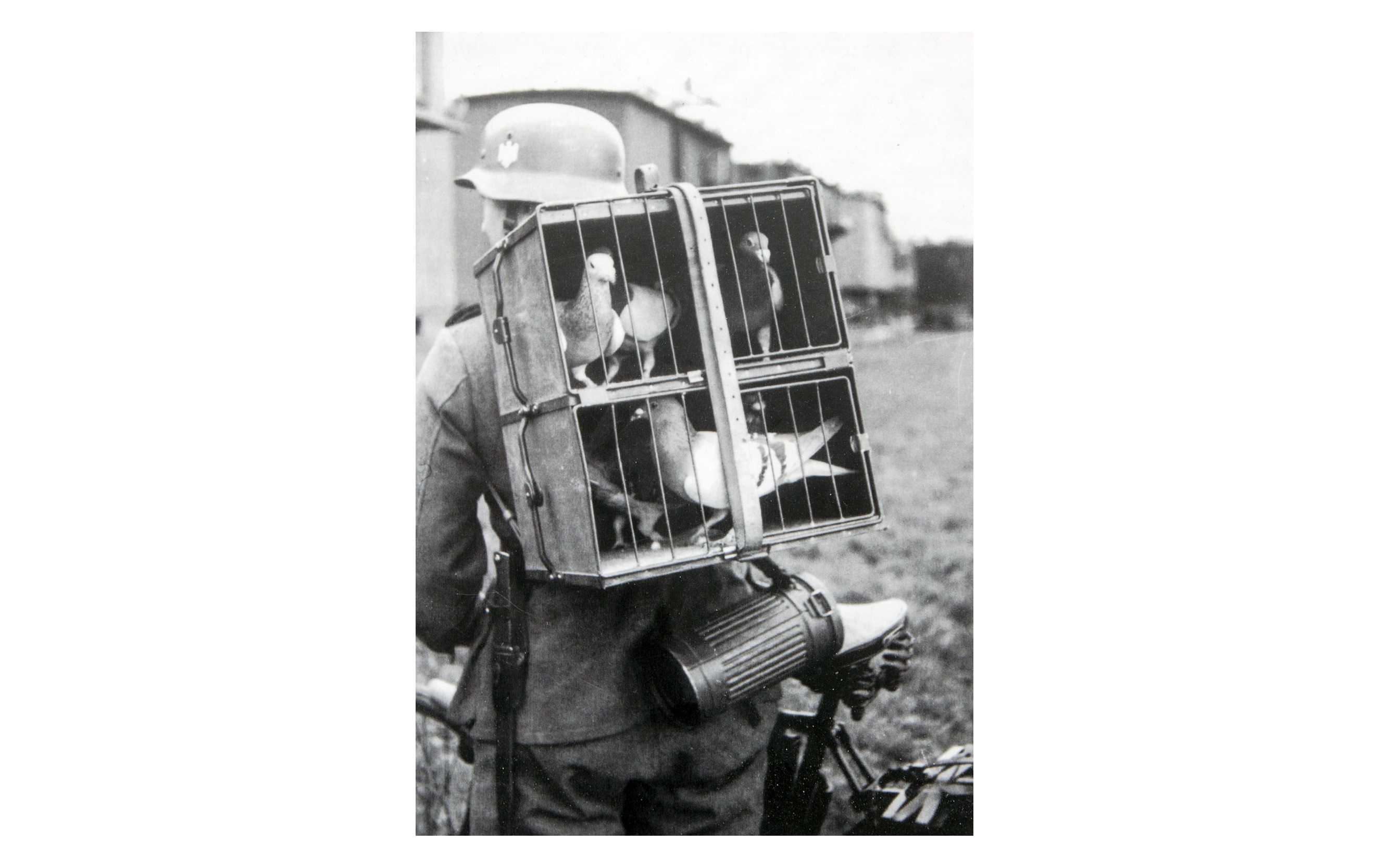
A German soldier on a mission with pigeons on his back.
Duifke Lacht ...
Straight after the War, Belgian pigeon racing resumed in full glory. During the most recent heyday of Belgian pigeon racing (i.e. 1948), the brothers brought out a new journal onto the market: "Duifke Lacht [Laughing dove]". It was a light-hearted, purely publicity-oriented journal for promoting Natural grain mixes.
"Duifke Lacht" came out twice a month. Advertising was alternated with fun facts, jokes and cartoons. The circulation climbed and climbed, and the orders kept on streaming in. Pigeon fanciers who were not subscribers were sent the complimentary, “Kom, Kom [Come, Come]". "Kom, Kom" was purely an advertisement pamphlet, consisting of one article on pigeon racing with the rest being adverts for the Natural grain mixes, and then also a series of Natural ‘complementary products’.
In 1967, the two journals "Het Duivensport" en "Duifke Lacht" were merged into one, "Duifke Lacht": reading material for 150,000 pigeon fanciers.
"Duifke Lacht" remains enormously popular as to this day.

‘Het Duivensport’ was renamed ‘De Duivensport’ in 1967 (new spelling).
Pigeon clocks
Pigeon racing and pigeon clocks (constateurs), are two inextricable variables. The Descheemaecker brothers were soon on to this notion.
During the racing season of 1949, Edgar Heirman, a well-known watchmaker, came to the clubhouse. There he heard that some fanciers had lost a race because their clock had stopped. Edgar was a pigeon fancier, and he thought it unacceptable that a race could be lost due to a poorly working clock. With that, he decided to design a ‘real’ pigeon clock, or ‘constateur’. Edgar constructed the ‘Heirman‘ constateur, which pigeon fanciers instantly liked very much. Edgar had developed a mechanism that accurately and infallibly recorded the time of arrival. The apparatus was barely 12 by 25 cm. In collaboration with the Descheemaeker brothers, a great many of these Heirman constateurs were produced in La Chaux-de-Fonds, a Swiss town known for its watch-making industry. Production was financially supported with subsidies from the Swiss government. No fewer than 16,000 Heirman clocks were sold. In those days, the Heirman was the Rolls-Royce of pigeon clocks. They could, as it were, be left in a cupboard for 50 years, then once wound up again, they would work accurately right away. The Heirman was unique in the world of constateurs at the time. A quite expensive clock, but with the most advanced mechanism, and Swiss top quality.
But pigeon clocks must also evolve with the times.
In 1952, the ‘Junior‘ appeared on the market. This was a revolutionary design, and no fewer than 300,000 were sold. The ‘Junior‘ company was founded, and Frans Descheemaecker, the oldest son of Noël, was put in charge. A son of Frans later brought an electronic quartz clock onto the market. Sales sank to 10,000 units, for there was great competition, and better electronic clocks were available. The company was sold off.
It may be stated that the Descheemaecker Brothers also laid the foundation of all aspects of constateurs.
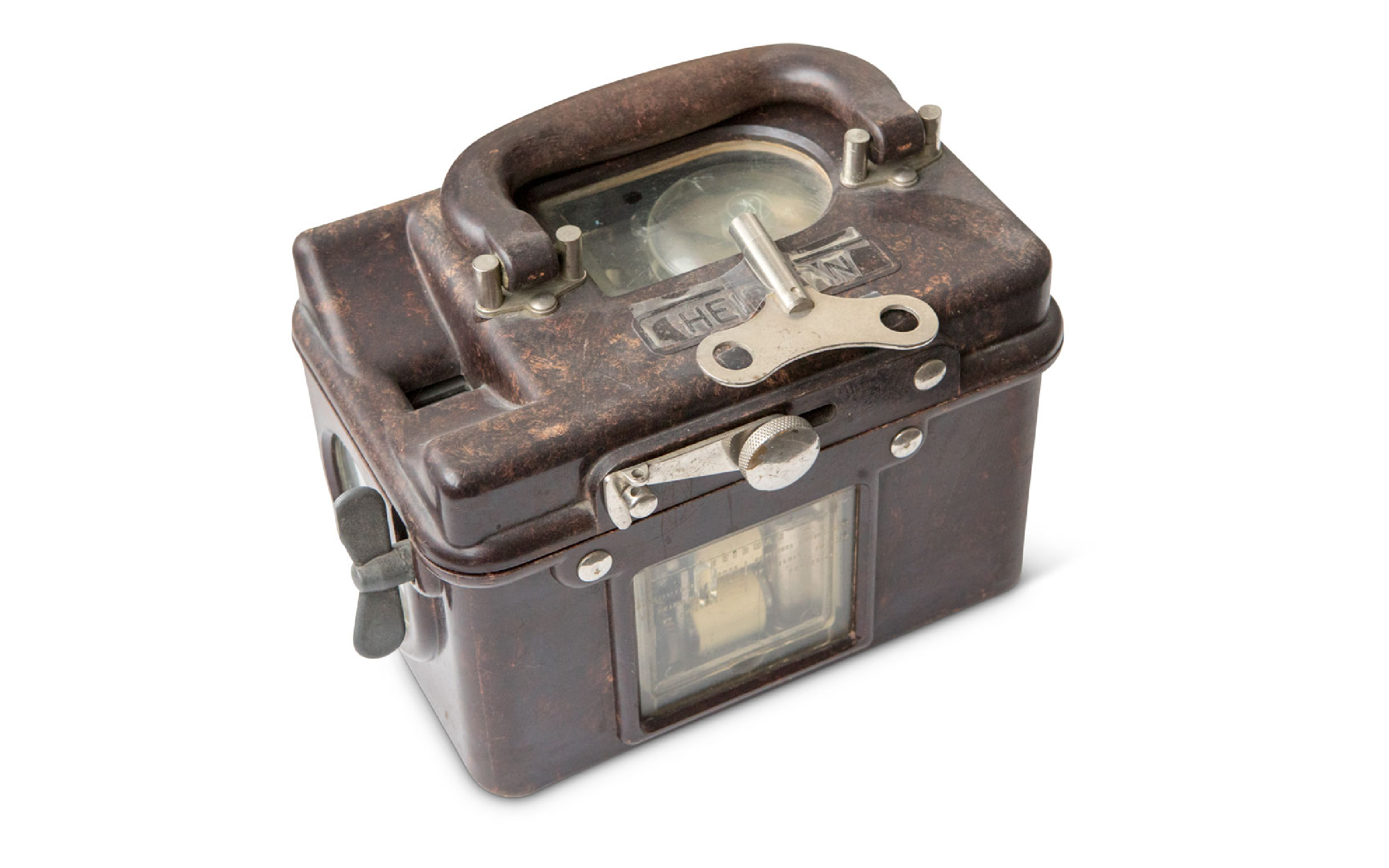
The Descheemaecker brothers introduced the ‘Heirman’ race timer clock, invented by Edgard Heirman, on the market in 1949.
The Breeding Station
Natural was a smoothly running business that produced grain mixes and a series of excellent secondary products: grit, minerals, tea, brewer‘s yeast, electrolytes, tobacco stems, floor granules, ... .The journal "Duifke Lacht" was a success as well. The brothers’ business instinct remained sharply focussed. But there was something missing from the total picture: pigeons. In 1955, a breeding station was constructed in Zoersel. Breeding pigeons of all known races found a haven there.But then, how to find customers for all those young reared pigeons?The brothers once again came up with a clever idea. Buy a sack of grain mix, and you get a voucher. With every 250 kg grain purchased, there were enough vouchers collected to exchange for a pigeon. "Duifke Lacht" ensured that every pigeon fancier was informed, and the collecting could then begin. It was not long before it became a success, and extra dovecotes had to be built to supply demand.Pigeon owners began asking whether they could visit the Natural factory and Breeding Station. This inspired the brothers to organise 12 weeks of open days on Sundays. Pigeon clubs organised buses for their members, and made a daytrip of it.The morning was spent visiting the pigeon market in Lier, then the factory, and the breeding pigeons were admired in the afternoon at the Breeding Station. A Trappist beer in the reception room of the Breeding Station brought the day to a close. A Sunday with 70 parked buses was not exceptional.The Natural Breeding Station is simply unique in the small world of pigeon racing.

The Descheemaecker brothers pose before a playpen at the Breeding Station.
The world beckons.
In 1970, two sons of Noël Descheemaecker, Joseph and Noël Jr., took over the company. A new, modern factory was built in Schoten for the sole production of pigeon grain mixes.
The Descheemaecker brothers had acquired name and fame in Belgian pigeon racing, but also in other countries. On the open days at the Breeding Station, many foreigners came to experience the Descheemaecker phenomenon. In particular, the neighbouring countries of France, the Netherlands and Germany were interested in the grain mixes, complementary products, and the Descheemaecker pigeons.
Joseph and Noël Jr. soon understood that international business expansion should be sought.
In 1966, Natural Granen hired a space at the National Exhibition in Germany. From the Van Hool bus factory, they hired a superb stand with various compartments, and a special showcase for displaying the grain mixes. This had never been seen before at a pigeon show, and the hostesses in their silver mini-skirts will most certainly have had something to do with that. Natural Granen was the first to do this in a professional manner, and became the trend setter for pigeon shows.
The strategy of exchanging a pedigree pigeon for collected vouchers was also applied in Germany, which proved to be a particularly interesting market to which Joseph and Noël Jr. would fully commit themselves.
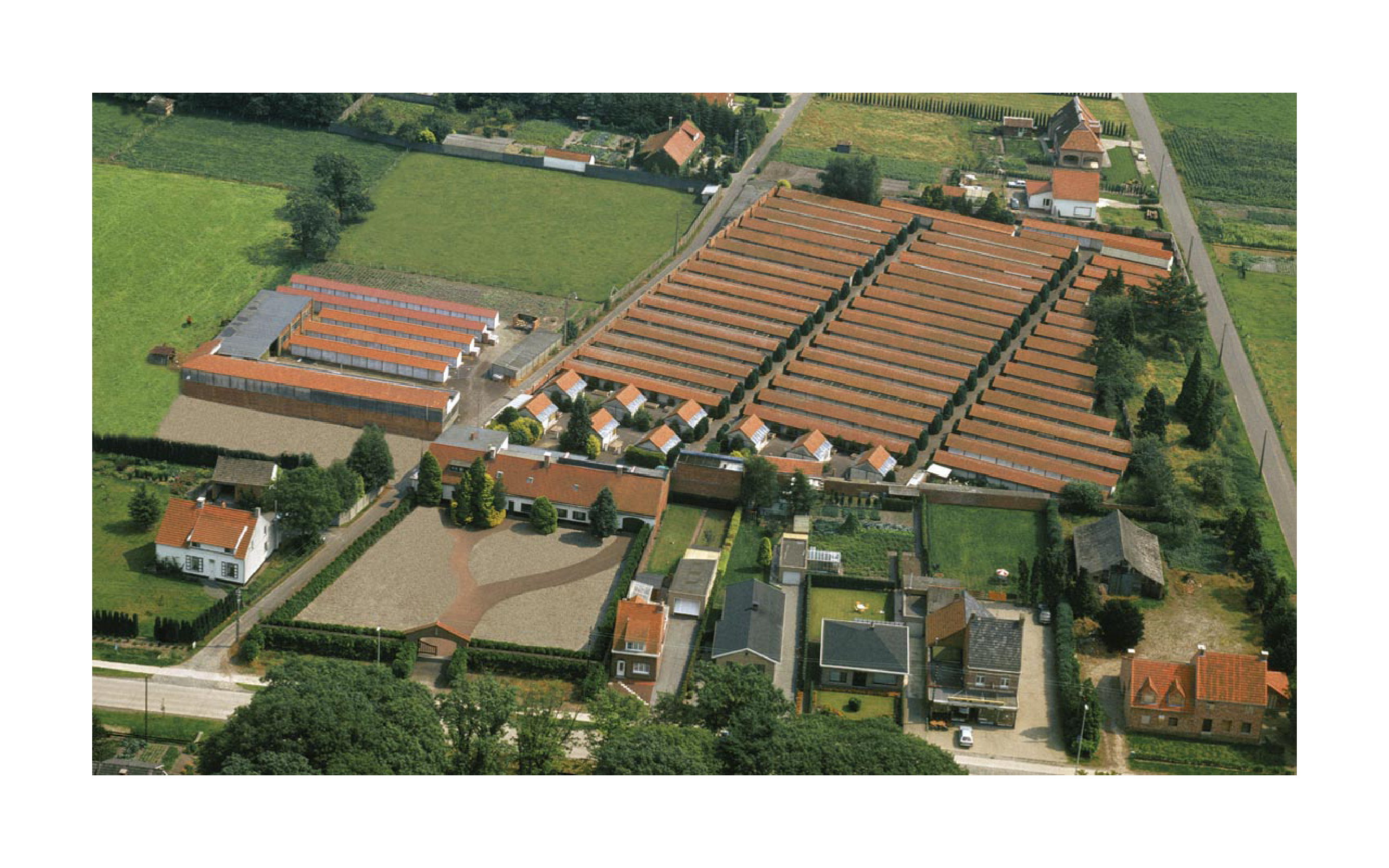
The Natural Breeding Station.
The starting pistol had been fired.
The Natural Granen stand was the centre of attention at all the prominent trade fairs and Olympiads. In 1981, the Olympiad was held in Tokyo, which opened the door to the Far East. Belgium is, and remains, the cradle of pigeon racing. Natural Granen was known world-wide as a reliable company for its grain mixes, journals and publications, complementary products, and the pigeons from the Breeding Station. The name of Descheemaecker opened doors.
Natural Granen grew exponentially.
It was not long before Natural Granen was exporting to 55 countries, and becoming the clear market leader in most of them.

Some of the world-renowned Natural complementary products.
More than just pigeon racing.
In 1988, Joseph and Noël Jr. purchased an egg food factory, and a bird seed factory in 1989. With a view to the future, for the first time they deviated from the beaten track of “pigeon racing only“.
In 2016, Haspeslagh, a company specialising in racing pigeon equipment, was taken over.
August 1996 saw the first business trip to China. Two years later, the first Natural shop opened in Shanghai. With a potential of 300,000 pigeon fanciers, China is not only a huge market, but a business challenge as well. Together with their Taiwan partner, Dr. Max Yang, a veterinary doctor and ardent pigeon fancier, Joseph and Noël Jr. decided to conquer the Asian market. On the initiative of Dr. Max Yang, Natural developed an entire range of medicine for homing pigeons, aimed solely at the Asian market. Haspeslagh-Natural is now the leading supplier of racing pigeon equipment. And Natural China is becoming a prominent brand in Asian pigeon racing.

The Natural Granen booth in Langfang 2017.
Third generation of Descheemaeckers
In 1996, Stephan, son of Joseph Descheemaecker, began working in the company of his father and grandfather. In his last year of university, Stephan underwent internships in the factory and abroad to learn the tricks of the trade. During these internships, the importance of Cribs maize was regularly discussed. This maize is grown in France, and dried naturally. This naturally-dried maize has a very high germination capacity, and was soon used in all Natural mixes.
Natural Granen has been leading in the field of French Cribbs maize since the 1960s.
The Natural Breeding Station is also a test centre, where new products are thoroughly tested before being released onto the market.
In 2016, Stephan Descheemaecker started up a totally new factory in Schoten, with an ultra-modern, computer-controlled production process to tune the mixes even more finely to the requirements of national and international pigeon fanciers.
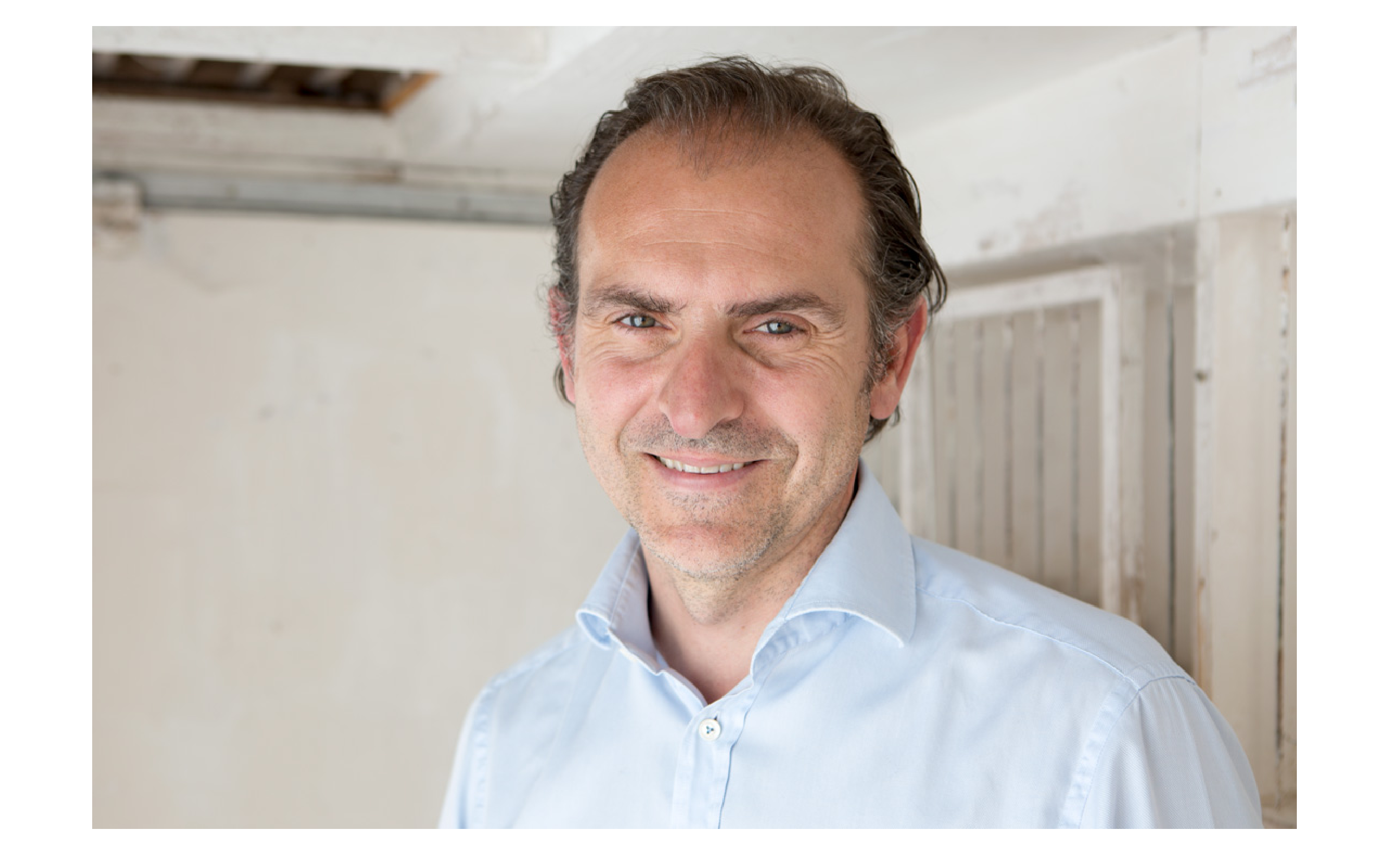
The third generation: Stephan Descheemaecker.
Elite dovecotes
Despite the waning interest in pigeon racing, Natural Granen continues to flourish at home and abroad. However, Stephan Descheemaecker feels that he must take action to ensure that pigeon racing in Belgium does not die out as a "sport for little old men".
In 2008, an external consultant was engaged to evaluate, together with the Board of Directors, the future of the Breeding Station. The opinions were divided, as the Breeding Station is particularly labour-intensive, and the annual figures none too encouraging. Should the Breeding Station be closed down to subdivide the land, or should it be expanded? The fact of the matter is that the Breeding Station has been strongly interwoven, year in and year out, with the philosophy of the company, and pigeon racing in general. The consultant put forward the idea that Descheemaecker had a potential goldmine on its hands, but a change of strategy was urgently needed.
In 2014, the 'Elite Dovecotes' were built. State-of-the-art housing populated with prize-winning pigeons with the most prestigious bloodlines.
In contrast to the classic young pigeons of the Breeding Station, more expensive pigeons with impressive pedigrees were now available. In the Elite Dovecotes, the pigeons receive the best care to develop into "real prize-winners".
The new strategy worked, and, in 2016, the Breeding Station achieved the highest turnover in its history. Genuine pigeon fanciers love to have a pigeon with the right lineage for a correct price, and such pigeons are now for sale at the Breeding Station.
In 2016, Stephan also started a Breeding Station for Elite Pigeons in China. The Elite Dovecotes are populated with 750 pigeons. None are sold yet, but they are raced in one-loft-races, which are one-day flights that earn high sums. A new and interesting path.
The prize money to be won in these one-loft races reaches into the millions. Collaboration could indeed give Belgian pigeon racing a substantial boost. The Chinese see it as an opportunity, and can't wait to put this collaboration into action.
Pigeon racing is currently evolving from a sport for old men into a professional pastime. Increasingly, clubs, friends, etc., are racing pigeons together. If you choose for combination dovecotes with multiple owners, you can easily take an occasional weekend off provided clear arrangements are made.
Modern pigeon racing offers many unique opportunities.
According to Stephan Descheemaecker, pigeon racing is the most beautiful hobby there is for people over 55 years. You stay mentally and physically active. The social contact keeps your mind sharp.
What more does a person need ...?

Elite of Natural: prize-winning pigeons with the most prestigious bloodlines.
